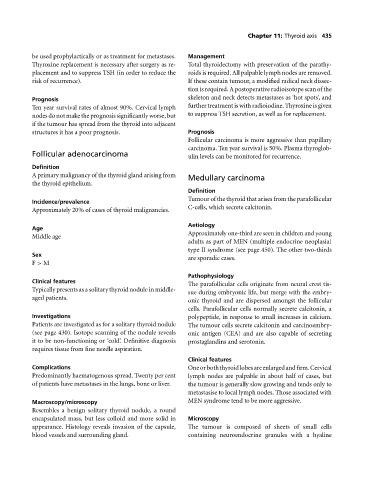Page 439 - Medicine and Surgery
P. 439
P1: FAW
BLUK007-11 BLUK007-Kendall May 25, 2005 8:5 Char Count= 0
Chapter 11: Thyroid axis 435
be used prophylactically or as treatment for metastases. Management
Thyroxine replacement is necessary after surgery as re- Total thyroidectomy with preservation of the parathy-
placement and to suppress TSH (in order to reduce the roids is required. All palpable lymph nodes are removed.
risk of recurrence). If these contain tumour, a modified radical neck dissec-
tion is required. A postoperative radioisotope scan of the
Prognosis skeleton and neck detects metastases as ‘hot spots’, and
Tenyear survival rates of almost 90%. Cervical lymph further treatment is with radioiodine. Thyroxine is given
nodes do not make the prognosis significantly worse, but to suppress TSH secretion, as well as for replacement.
if the tumour has spread from the thyroid into adjacent
structures it has a poor prognosis. Prognosis
Follicular carcinoma is more aggressive than papillary
carcinoma. Ten year survival is 50%. Plasma thyroglob-
Follicular adenocarcinoma ulin levels can be monitored for recurrence.
Definition
Aprimary malignancy of the thyroid gland arising from Medullary carcinoma
the thyroid epithelium.
Definition
Tumour of the thyroid that arises from the parafollicular
Incidence/prevalence
C-cells, which secrete calcitonin.
Approximately 20% of cases of thyroid malignancies.
Aetiology
Age
Approximately one-third are seen in children and young
Middle age
adults as part of MEN (multiple endocrine neoplasia)
type II syndrome (see page 450). The other two-thirds
Sex
are sporadic cases.
F > M
Pathophysiology
Clinical features
The parafollicular cells originate from neural crest tis-
Typically presents as a solitary thyroid nodule in middle-
sue during embryonic life, but merge with the embry-
aged patients.
onic thyroid and are dispersed amongst the follicular
cells. Parafollicular cells normally secrete calcitonin, a
Investigations polypeptide, in response to small increases in calcium.
Patients are investigated as for a solitary thyroid nodule The tumour cells secrete calcitonin and carcinoembry-
(see page 430). Isotope scanning of the nodule reveals onic antigen (CEA) and are also capable of secreting
it to be non-functioning or ‘cold’. Definitive diagnosis prostaglandins and serotonin.
requires tissue from fine needle aspiration.
Clinical features
Complications Oneorboththyroidlobesareenlargedandfirm.Cervical
Predominantly haematogenous spread. Twenty per cent lymph nodes are palpable in about half of cases, but
of patients have metastases in the lungs, bone or liver. the tumour is generally slow growing and tends only to
metastasise to local lymph nodes. Those associated with
Macroscopy/microscopy MEN syndrome tend to be more aggressive.
Resembles a benign solitary thyroid nodule, a round
encapsulated mass, but less colloid and more solid in Microscopy
appearance. Histology reveals invasion of the capsule, The tumour is composed of sheets of small cells
blood vessels and surrounding gland. containing neuroendocrine granules with a hyaline

